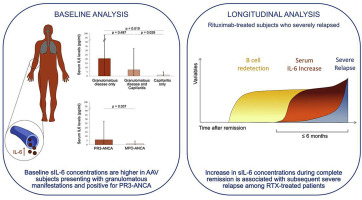当前位置:
X-MOL 学术
›
J. Autoimmun.
›
论文详情
Our official English website, www.x-mol.net, welcomes your
feedback! (Note: you will need to create a separate account there.)
The association of serum interleukin-6 levels with clinical outcomes in antineutrophil cytoplasmic antibody-associated vasculitis.
Journal of Autoimmunity ( IF 7.9 ) Pub Date : 2019-07-15 , DOI: 10.1016/j.jaut.2019.07.001 Alvise Berti 1 , Roscoe Warner 2 , Kent Johnson 2 , Divi Cornec 1 , Darrell R Schroeder 1 , Brian F Kabat 1 , Carol A Langford 3 , Cees G M Kallenberg 4 , Philip Seo 5 , Robert F Spiera 6 , E William St Clair 7 , Fernando C Fervenza 1 , John H Stone 8 , Paul A Monach 9 , Ulrich Specks 1 , Peter A Merkel 10 ,
Journal of Autoimmunity ( IF 7.9 ) Pub Date : 2019-07-15 , DOI: 10.1016/j.jaut.2019.07.001 Alvise Berti 1 , Roscoe Warner 2 , Kent Johnson 2 , Divi Cornec 1 , Darrell R Schroeder 1 , Brian F Kabat 1 , Carol A Langford 3 , Cees G M Kallenberg 4 , Philip Seo 5 , Robert F Spiera 6 , E William St Clair 7 , Fernando C Fervenza 1 , John H Stone 8 , Paul A Monach 9 , Ulrich Specks 1 , Peter A Merkel 10 ,
Affiliation

|
OBJECTIVE
To investigate serum IL-6 (sIL-6) levels during active disease, complete remission (CR), and relapse in antineutrophil cytoplasmic antibody (ANCA)-associated vasculitis (AAV), and to explore the association of changes in sIL-6 with clinical outcomes.
METHODS
sIL-6 levels were measured at baseline and longitudinally over 18 months, in 78 patients with AAV enrolled in a randomized controlled trial comparing treatment with either rituximab (RTX) or cyclophosphamide (CYC)/azathioprine (AZA). Outcome variables included baseline clinical features, ANCA specificity, disease activity (active disease versus CR), time to relapse events, B cell repopulation, and ANCA titer increases.
RESULTS
At baseline, sIL6 levels were detectable in 81% of patients; 73% (n = 57) of subjects were proteinase 3 (PR3)-ANCA positive, sIL-6 levels were higher in subjects with PR3-ANCAs and positively correlated with their levels (rs = 0.36,p < 0.01), but not with levels of myeloperoxidase (MPO)-ANCA (rs = -0.17,p = 0.47). Higher baseline sIL-6 levels were associated with PR3-ANCA positivity, fever, pulmonary nodules/cavities, conductive deafness, and absence of urinary red blood cell casts (p < 0.05). Baseline sIL6 levels did not predict CR at month 6 (p = 0.71), and the median sIL-6 level declined from baseline with induction therapy, regardless of CR achievement. An increase in sIL-6 during CR was a predictor for subsequent severe relapse in RTX-treated patients (hazard ratio (HR):7.24,p = 0.01), but not in CYC/AZA-treated patients (HR:0.62,p = 0.50). In contrast, a sIL-6 increase did not predict B cell repopulation or ANCA titer increase in either treatment arm (p > 0.05).
CONCLUSION
At baseline, sIL-6 concentrations correlate with PR3-ANCA titers and are associated with specific clinical manifestations of AAV. Baseline sIL6 concentrations do not predict CR at 6 months, but the increase in sIL-6 concentrations during CR is associated with subsequent severe relapse among RTX-treated patients. Further investigation into the mechanistic role of IL6 in AAV might lead to identifying this pathway as a potential therapeutic target in this disease.
中文翻译:

血清白细胞介素 6 水平与抗中性粒细胞胞浆抗体相关性血管炎临床结果的关联。
目的 探讨抗中性粒细胞胞浆抗体(ANCA)相关性血管炎(AAV)疾病活动期、完全缓解(CR)和复发期间血清IL-6(sIL-6)水平,并探讨sIL-6变化之间的关联。与临床结果。方法 在一项随机对照试验中,对 78 名 AAV 患者进行基线测量和 18 个月内的纵向 sIL-6 水平测量,该试验比较了利妥昔单抗 (RTX) 或环磷酰胺 (CYC)/硫唑嘌呤 (AZA) 的治疗。结果变量包括基线临床特征、ANCA 特异性、疾病活动性(活动性疾病与 CR)、复发事件时间、B 细胞再增殖和 ANCA 滴度增加。结果 在基线时,81% 的患者可检测到 sIL6 水平;73% (n = 57) 的受试者为蛋白酶 3 (PR3)-ANCA 阳性,PR3-ANCA 受试者的 sIL-6 水平较高,并与其水平呈正相关 (rs = 0.36,p < 0.01),但与髓过氧化物酶 (MPO)-ANCA 水平(rs = -0.17,p = 0.47)。较高的基线 sIL-6 水平与 PR3-ANCA 阳性、发热、肺结节/空洞、传导性耳聋和尿红细胞管型缺失相关(p < 0.05)。基线 sIL6 水平并不能预测第 6 个月时的 CR (p = 0.71),并且无论是否达到 CR,诱导治疗后中位 sIL-6 水平均较基线有所下降。CR 期间 sIL-6 的增加是 RTX 治疗患者随后严重复发的预测因子(风险比 (HR):7.24,p = 0.01),但 CYC/AZA 治疗患者则不然(HR:0.62,p = 0.01) 0.50)。相反,sIL-6 的增加并不能预测任一治疗组中 B 细胞的重新增殖或 ANCA 滴度的增加 (p > 0.05)。结论 在基线时,sIL-6 浓度与 PR3-ANCA 滴度相关,并且与 AAV 的特定临床表现相关。基线 sIL6 浓度不能预测 6 个月时的 CR,但 CR 期间 sIL-6 浓度的增加与 RTX 治疗患者随后的严重复发相关。进一步研究 IL6 在 AAV 中的机制作用可能会确定该通路作为该疾病的潜在治疗靶点。
更新日期:2019-11-18
中文翻译:

血清白细胞介素 6 水平与抗中性粒细胞胞浆抗体相关性血管炎临床结果的关联。
目的 探讨抗中性粒细胞胞浆抗体(ANCA)相关性血管炎(AAV)疾病活动期、完全缓解(CR)和复发期间血清IL-6(sIL-6)水平,并探讨sIL-6变化之间的关联。与临床结果。方法 在一项随机对照试验中,对 78 名 AAV 患者进行基线测量和 18 个月内的纵向 sIL-6 水平测量,该试验比较了利妥昔单抗 (RTX) 或环磷酰胺 (CYC)/硫唑嘌呤 (AZA) 的治疗。结果变量包括基线临床特征、ANCA 特异性、疾病活动性(活动性疾病与 CR)、复发事件时间、B 细胞再增殖和 ANCA 滴度增加。结果 在基线时,81% 的患者可检测到 sIL6 水平;73% (n = 57) 的受试者为蛋白酶 3 (PR3)-ANCA 阳性,PR3-ANCA 受试者的 sIL-6 水平较高,并与其水平呈正相关 (rs = 0.36,p < 0.01),但与髓过氧化物酶 (MPO)-ANCA 水平(rs = -0.17,p = 0.47)。较高的基线 sIL-6 水平与 PR3-ANCA 阳性、发热、肺结节/空洞、传导性耳聋和尿红细胞管型缺失相关(p < 0.05)。基线 sIL6 水平并不能预测第 6 个月时的 CR (p = 0.71),并且无论是否达到 CR,诱导治疗后中位 sIL-6 水平均较基线有所下降。CR 期间 sIL-6 的增加是 RTX 治疗患者随后严重复发的预测因子(风险比 (HR):7.24,p = 0.01),但 CYC/AZA 治疗患者则不然(HR:0.62,p = 0.01) 0.50)。相反,sIL-6 的增加并不能预测任一治疗组中 B 细胞的重新增殖或 ANCA 滴度的增加 (p > 0.05)。结论 在基线时,sIL-6 浓度与 PR3-ANCA 滴度相关,并且与 AAV 的特定临床表现相关。基线 sIL6 浓度不能预测 6 个月时的 CR,但 CR 期间 sIL-6 浓度的增加与 RTX 治疗患者随后的严重复发相关。进一步研究 IL6 在 AAV 中的机制作用可能会确定该通路作为该疾病的潜在治疗靶点。







































 京公网安备 11010802027423号
京公网安备 11010802027423号